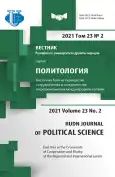Северокорейские плакаты как инструмент пропаганды
- Авторы: Воробьева А.К.1, Рагозина С.С.1
-
Учреждения:
- Казанский федеральный университет
- Выпуск: Том 23, № 2 (2021): Восточная Азия на перекрестке сотрудничества и соперничества на региональном и международном уровнях
- Страницы: 316-330
- Раздел: СОЦИОКУЛЬТУРНОЕ РАЗВИТИЕ КОРЕИ
- URL: https://journal-vniispk.ru/2313-1438/article/view/322126
- DOI: https://doi.org/10.22363/2313-1438-2021-23-2-316-330
- ID: 322126
Цитировать
Полный текст
Аннотация
Пропаганда - это неотъемлемая часть существования северокорейского общества. В условиях почти полного отсутствия цифровых информационных носителей, достаточно низкого уровня жизни и образования населения, продвижение проправительственных лозунгов становится частью каждодневной рутины. Ее главная функция - это сохранение полного беспрекословного подчинения правительству и восхваление выдвигаемых им идей. Опираясь на семиотическую методологию, в данной статье подробно рассматривается процесс проявления визуальной агитации на примере пропагандистских плакатов, определяются их отличительные особенности как одного из ключевых элементов сложной системы северокорейской пропаганды. Актуальность данной работы заключается в повышенном интересе к феномену пропаганды Северной Кореи на международной арене. Целью данной работы является изучение особенностей пропаганды КНДР на примере агитационных плакатов. Задачами данной работы являются cтруктурирование агитационной системы и классификация агитационных плакатов с их сопутствующим переводом, рассмотрение лозунгов и посылов, заложенных в данный вид пропаганды.
Ключевые слова
Об авторах
Анастасия Константиновна Воробьева
Казанский федеральный университет
Автор, ответственный за переписку.
Email: vavv25@yandex.ru
ORCID iD: 0000-0003-3305-2598
студент Высшей школы международных отношений и востоковедения Института международных отношений
Казань, Российская ФедерацияСабина Сергеевна Рагозина
Казанский федеральный университет
Email: sabi.ragozina@gmail.com
ORCID iD: 0000-0003-1177-9200
старший преподаватель кафедры алтаистики и китаеведения Института международных отношений
Казань, Российская ФедерацияСписок литературы
- Asmolov, K. (2017). Korean Political Culture: Tradition and Transformation (2nd ed.). Moscow: Dmitry Pozharsky University. (In Russian).
- Asmolov, K. (2018). Not just missiles: a historian’s journey to North Korea. Moscow: Dmitry Pozharsky University. (In Russian).
- Asmolov, K., & Lebedev, V. (2021). North Korea’s Ideology and Propaganda: Signs of Change. Russia in Global Affairs, 1(19), 70-97.
- Chaus, N.V. (2010). Soviet posters of 1917-1920. The main means of promoting socialist ideology. Socio-economic phenomena and processes, 6, 220-223. (In Russian).
- Gabroussenko, T. (2011). From Developmentalist to Conservationist Criticism: The New Narrative of South Korea in North Korean Propaganda. Journal of Korean Studies, 16(1), 27-61.
- Lankov, A. (2007). North of the DMZ: Essays on Daily Life in North Korea. Seattle: McFarland & Compan.
- Lee, J.W., & Bairner, A. (2009). The Difficult Dialogue: Communism, Nationalism, and Political Propaganda in North Korean Sport. Journal of Sport and Social Issues, 4(33), 390-410.
- Park, С. (2020). Propaganda Posters and “Visual Agitation (jikkwan sondong)” in DPRK: Studying the Process of Internalizing Agitation Propaganda. Korean Bulletin of Art History, 54, 205-221. (In Korean).
- Sommer, M. (2017). Pyongyang, Propaganda and Postage Stamps. North Korean Review, 13(2), 74-83.
- Zhang, N. (2016). Propaganda Visualizations of the Chinese Communist Party in Posters & Magazine Covers during 1989-2009. Helsinki: Aalto University.
Дополнительные файлы









